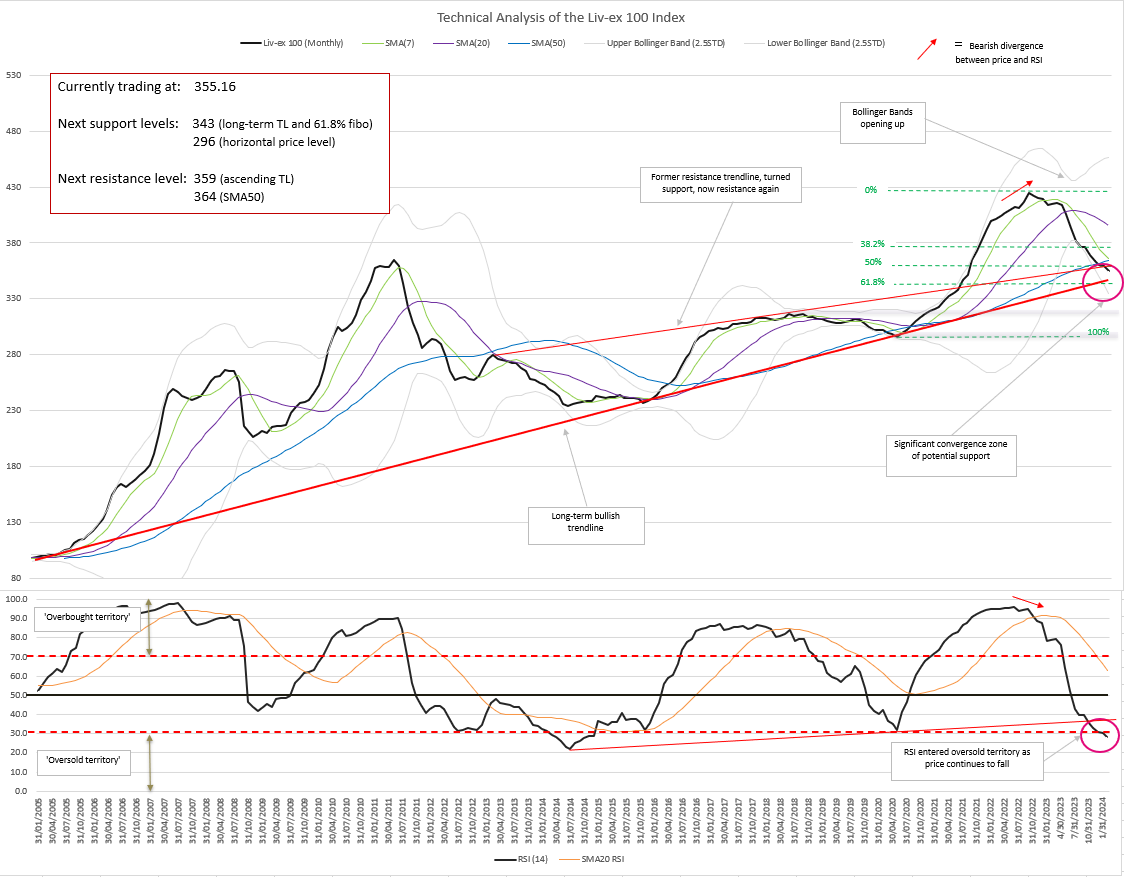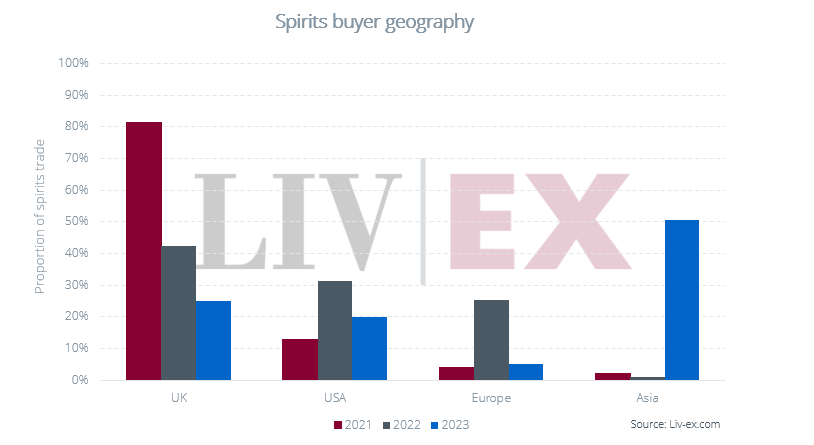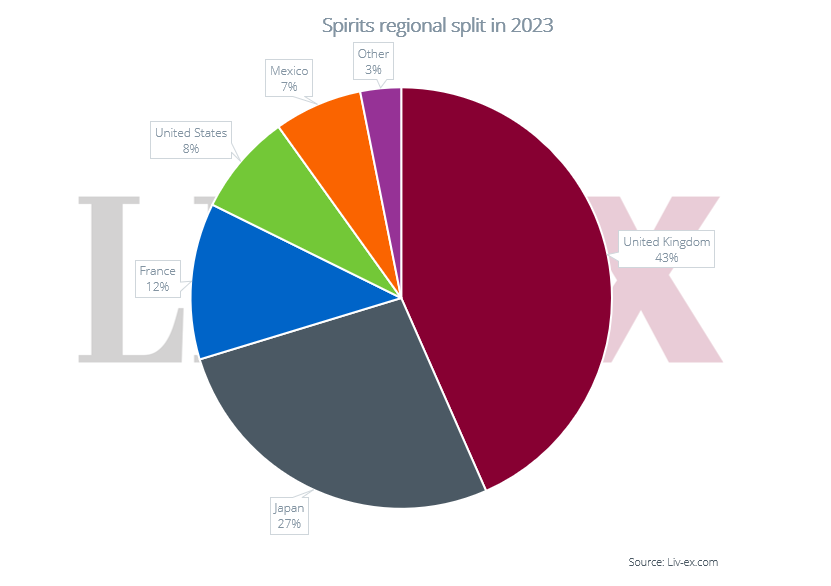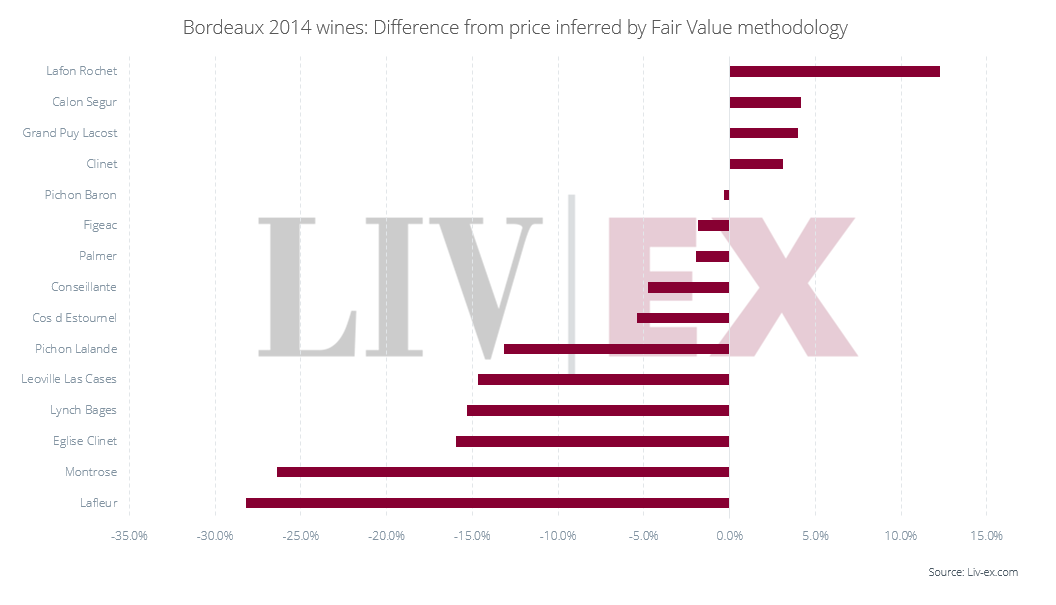March Market Report
Share this article | Print this article
- Further falls in the major Liv-ex indices in February.
- But signs of optimism in Italy and Champagne, with the Champagne 50 rising for the first time since October 2022.
- Are the bears here to stay? A Technical analyst looks at the Liv-ex Fine Wine 100.
- We explore the growing interest in spirits on Liv-ex as a Scotch Whisky Association report reports that ‘export sales have soared in recent years’.
- As Jane Anson tastes Bordeaux 2014 ten years on, we examine which represent fair value, and which do not.
- As William Kelley revises his in-barrel scores for 2021s, we look at their recent price performance.
Introduction
Glass half full or half empty?

*data taken on the 7th of March 2024. The FTSE 100 was last updated on the 29th of February. The Liv-ex Fine Wine 50 is updated daily.
The Liv-ex Fine Wine 50 was the best-performing of the major Liv-ex indices. As of the 7th of March, it had fallen by 0.5% compared to falls of 1.3% and 1.1% for the Liv-ex 1000 and Liv-ex Fine Wine 100 respectively. February’s 1.1% fall in the Liv-ex Fine Wine 100 was its 11th consecutive monthly decline, and sharper than January’s 0.3% fall.
The broader market, represented by the Liv-ex Fine Wine 1000, has seen a marked variance in the performance of its sub-indices. Since the start of the year, prices of the wines on the index have fallen by an average of 3.5%. This has been driven in the most part by a 5.5% decline in the Burgundy 150, a 4.8% drop in the Rhone 100, and a 3.6% fall in the Rest of the World 60.
In contrast, things are looking a little brighter in Italy and Champagne; slight declines in January were followed by modest rises in February. In the case of the Champagne 50, its 1% rise was its first positive movement since October 2022.
February saw an increase in both the number of brands (LWIN7s) and individual wines (LWIN11s) traded on the secondary market. There was a slight rise in both traded value and volume, as well as exposure (the value of bids and offers on the exchange) compared to the previous month.
Away from fine wine, February was a broadly positive month for equity markets, with the FTSE posting a flat performance and the DAX, Hang Seng and S&P 500 all rising.
Major Market Movers
Reasons to be cheerful in Italy and Champagne
As the recent retracements in the major indices continue, positive signs are emerging from Italy and Champagne.
The Italy 100 posted a 0.1% rise in February; its second modest monthly rise in the last three months. Recent 2021 releases of Sassicaia and Ornellaia, and the imminent release of Tignanello have perhaps stimulated interest in back vintages of Tuscan wines. Three of the five wines that showed double-digit month-on-month increases were Tuscan; Fontodi, Flaccianello delle Pieve, Colli della Toscana Centrale 2018 and 2020, and Tignanello, Toscana 2015. Piedmont accounted for the remaining two double-digit risers; Giacomo Conterno, Barolo, Monfortino Riserva 2015 and Gaja, Barbaresco 2010.
Tignanello, Toscana 2015 trades on Liv-ex

Tignanello 2015 has a Market Price of £1,440 (12×75) and received 98 points from James Suckling, Monica Larner and Antonio Galloni. Vinous gave the same score to the soon-to-be-released 2021.
Larger price rises were seen in the Champagne 50 which climbed 1% in February; its first increase since October 2022. Since then the index has pulled back 22.9%. The three biggest risers included Salon, Le Mesnil Grand Cru 2012 and Krug, Vintage Brut 2004, which both saw their second successive monthly rise, and Dom Perignon, Rose 2009. Krug 2011 will be released at the end of the month. In total, 23 Champagnes saw month-on-month rises in February.

The mid-price for Salon 2012 is significantly higher than its ex-London release price of £5,800 (12×75). The same is true for Krug 2004, which had an ex-London price of £1,900 (12×75). In contrast, Dom Perignon Rose was released ex-London at £3,120; higher than its current Mid-Price and its last trade price on Liv-ex.
What does the Champagne 50’s February rise mean for the future of Champagne prices? We’ll soon be publishing a technical analysis of the index to explore this question, available to Liv-ex members on a Gold package or higher.
Chart of the Month
Liv-ex Fine Wine 100; the bears remain in control
The Liv-ex Fine Wine 100 has been falling steadily for 18 months and is nearing a 20% correction. What next for the index? Technical analysis highlights that, while the long-term trend remains bullish with the price remaining above the long-term trendline from 2005, the index has fallen below the previous high in 2011. In 2024, it has broken through both the ascending trendline resistance, which was formerly the support line until February 2024, and the Simple Moving Average line for the last 50 months (the SMA50). The index has now fallen 50% since the start of the last major upward trend which began in Spring 2020, as shown by the Fibonacci Retracements. Analysts suggest this is ‘a major alert to the long-term bullish trend.’

Analysts might expect the bearish momentum to accelerate, with prices falling further. The Bollinger Bands continue to widen indicating increasing price volatility. While the Relative Strength Index (RSI) at the bottom of this chart has now broken through the 30 line to indicate that the index has become ‘oversold’ for the first time since 2014. The simple seven month moving average (SMA7) is about to cross the SMA50 again, foreboding a possible long-term trend reversal.
Technical analysis might suggest further losses in the coming months. For more about technical analysis; How to predict fine wine prices
News Insight
Scotch whisky is raising spirits
According to a recent report by the Scotch Whisky Association (SWA) cited by Decanter, the Scotch whisky industry contributed £7.1bn to the UK economy in 2022 (£5.3bn to the Scottish economy and £1.8bn in the rest of the UK). The report further added that ‘export sales have soared in recent years amid growing demand for Scotch whisky in key markets such as the USA, France, Singapore, Taiwan, China and India’.
Regional split
Demand for spirits on the secondary market has experienced a shift, with new regions demonstrating heightened interest. Singapore was the driving force behind Asia’s demand, boosting the region to account for 50.4% of buyers in 2023. However, so far this year, the UK has been leading trade with 67.8% of buyers, followed by Europe with 26.1%.

In terms of origin, Scottish spirits dominated the secondary market in 2023, accounting for 43.4% of purchases, followed by Japanese spirits with 26.9% of the total.

Most sought-after spirits
In 2023, the most bid-for spirit was the Glenfarclas, Highland Single Malt 25YO, closely followed by Baron Rothschild, Lafite Tres Vieille Reserve, Hibiki (Suntory) Blended 21YO and Yamazaki (Suntory) Single Malt 12YO. Macallan, Speyside Highland Single Malt Vintage Sherry Oak Cask 18YO was the most searched-for spirit by Liv-ex members.
In terms of trading activity in 2023, the most traded spirit by value was Yamazaki (Suntory), Single Malt Mizunara Japanese Oak 100th Anniversary Suntory Whisky 18YO, fetching a last trade price of £1,717 per bottle, closely followed by Macallan, Highland Single Malt Sherry Oak Cask 30YO Bottled 2023, which last traded at £3,667 per bottle.
By volume and number of trades, Glenfarclas, Highland Single Malt 25YO came out on top, with a last trade price of £122 a bottle. It was followed by Blanton’s Kentucky Straight Bourbon The Original Single Barrel, last trading at £72 per bottle.
You can find all spirit offers on Liv-ex in the Opportunities tab.

Critical Corner
Jane Anson’s account of 2014 Bordeaux, 10 years on
Jane Anson recently released her review of Bordeaux’s 2014 Vintage: Ten Years On, in which she tasted and scored 62 wines.
The writer and critic awarded three wines a score of 98 points, while 22 wines fell within the 95-97 points range. Following the tasting, she proclaimed the 2014 vintage ‘the best vintage since 2010, although not as concentrated and long-lasting, with many wines offering pleasure today’. She does note, however, that it ‘leans towards Left Bank, with particular successes in the northern Médoc, particularly St Julien, St Estèphe and Pauillac’.
The best vintage since 2010, although not as concentrated and long-lasting, with many wines offering pleasure today.
Jane Anson
We looked at wines from the report whose market are correlated with Jane Anson scores and found 15. According to Liv-ex’s Fair Value methodology, four of these wines landed above the ‘fair value’ line and 11 below it, therefore offering relative value compared to other vintages.

As per the chart above, of these 11 wines, Château Lafleur 2014 comes in the lowest below the Fair Value line. The wine has a Market Price of £5,800 per 12×75 and boasts a score of 97 points from Jane Anson.
Closely behind Lafleur is Château Montrose 2014, falling 26.4% below the Fair Value line with a Market Price of £950 per 12×75. The wine was initially scored 95 points by Jane Anson and later upgraded to 97 points in 2022. In her latest tasting note, the critic once again awarded the wine 97 points. Fellow 97-pointerChâteau Lynch-Bages 2014 has a Market Price of £575 per 12×75, meaning the wine comes in 15.3% below the Fair Value line. As shown in the table below, the 2014 has seen a 47.3% rise in its Market Price since release.

In terms of price performance, Château La Conseillante 2014 came out on top, having seen its Market Price rise by 9.1% in the last year and 44.6% in the last 5 years. However, it’s also one of the lower-scored wines in Jane Anson’s report; the critic downgrading it from 94 points in 2021 to 92 points in the latest round of tastings.
There are 184 LIVE bids and offers for Bordeaux 2014 wines on Liv-ex. Log in to the exchange to view them and trade.

Final Thought
Bordeaux 2021, a cautionary tale
William Kelley recently published his Bordeaux 2021 in-bottle scores in a report titled ‘The Saved and the Damned’.
Kelley begins his account by noting that as they were ‘released at high prices and soon overshadowed by excitement for the 2022s, the 2021 Bordeaux vintage is already in danger of being forgotten’. To his question, ‘how have the wines actually turned out?’, the answer is: slightly worse off than was previously thought.
The critic scored 337 wines, 40 of which fall within the Bordeaux 500 and were scored by Kelley in barrel in 2022. On average, they were downgraded by 0.4 points in the most recent round of scoring.
Note: for wines awarded an in-barrel range in 2022, the mid-point of the score was used for consistency and fairness of evaluation.
Among the aforementioned wines, Château Ausone 2021 had the most significant decline in score, initially scored 97-100 points in 2022 and subsequently downgraded to 94+ points. In his tasting note from 2022, Kelley identified Ausone as ‘a strong candidate for the title of wine of the vintage’. However, in the recent in-bottle tasting, he expressed uncertainty, stating ‘I’m sure time will be kind to it, but I’m not quite sure it will ever realize the magical potential it showed in April 2022’.
Another notable downgrade was recorded by Château Calon Ségur 2021, which dropped from 95-96 points in April 2022 to 93 points in bottle. Kelley initially praised it as ‘a brilliant effort that will delight Médoc purists’, but in bottle, he noted that ‘it appears to have lost a touch of aromatic precision during élevage’, nonetheless remaining ‘a compelling Calon-Ségur’.
On the other hand, Château Montrose 2021 was scored 94-96 points in barrel back in 2022, Kelley already calling the wine ‘a brilliant achievement’ at the time. The wine was upgraded to 97 points in bottle, the critic’s highest score in this report, even earning the title of ‘”wine of the vintage” in the Médoc’.
Fellow 97-pointers (also on the list of Kelley’s ‘Wines of the Vintage’) are Château Cheval Blanc 2021 and Château Haut-Brion 2021, which were initially scored 95-97 and 96-98 points in 2022 respectively.
Château Figeac is also one of Kelley’s ‘Wines of the Vintage’. The wine was awarded 94-97 points in 2022 and called ‘one of the highlights of the vintage on the Right Bank’ at the time. The wine was scored 96+ points in bottle, with Kelley mentioning the wine ‘is performing brilliantly in bottle’.
Last but not least, Château Léoville-Las-Cases 2021 was scored 95-97 points in barrel with Kelley calling it ‘one of the wines of the vintage’. In 2024, Kelley scored it 96+ points with Kelley mentioning ‘the 2021 Léoville Las Cases has turned out beautifully in bottle and clearly numbers among the very finest wines of the vintage’.

Where are the 2021s trading now?
Kelley ends his report on a rather ominous note, stating that ‘Given the state of the market, what’s more, the 2021s are likely to be available at a discount in the next year or two’.
Looking at the secondary market trade of the wines above, it looks like the critic’s prediction may well become a reality. Of the most traded 2021s over the last six months, those trades have been 18% below their ex-London release price on average, and on average, 8% below their current Market Price. Only two wines have a last traded price from the last six months that is higher. Château Beychevelle 2021 traded last week for £804 per case, 14% above its ex-London price, and Carruades de Lafite 2021 which last traded for £2,120 per case, 7% above its release price of £1,980.
